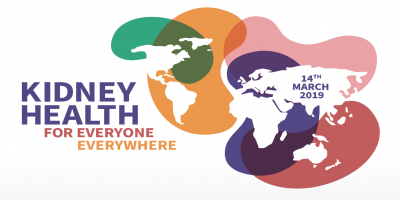Journée mondiale du rein

Le jeudi 14 mars 2019, le service de nephrologie des HUG organise une journée de sensibilisation et dépistage autour des maladies du rein.

Le jeudi 14 mars 2019, le service de nephrologie des HUG organise une journée de sensibilisation et dépistage autour des maladies du rein.
When the time comes, the assistant nurse or the nurse will help you install at the place you are assigned for the session. We make available several types of machines (generators).
You may be assigned a different machine than the one used in the previous session, but this would not interfere with your treatment. Thus you should not be surprised or concerned when you are assigned a different place.
Le moment venu, l’aide-soignante ou l’infirmière vous aide à vous installer à la place qui vous est attribuée pour la séance. Nous avons à disposition plusieurs types de machines (générateurs).
La machine peut être différente d’une séance à l’autre sans que cela n’interfère sur votre traitement. Ne soyez donc pas surpris ou inquiet si vous changez de place.
A hemodialysis session begins and ends with a weighing. The scales are the most reliable tools to assess the variation of weight between two sessions.
The weight gain is the amount of liquid that was not eliminated by your kidneys (water, tea, coffee, fruits, etc.). The higher it is, the more difficult the session will be to bear (risk of cramps, fatigue and hypotension).
It is recommended for the weight gain between two sessions to be less than 5% of the body weight.
Le début de votre dialyse n’est pas déterminé par votre heure d’arrivée, mais en fonction de :
Une séance d’hémodialyse débute et se termine par une pesée. La balance est la méthode la plus fiable pour évaluer la variation de poids entre deux séances.
A fistula is surgically created by connecting an artery and a vein in the arm. The vein (superficial, and easily accessible) will therefore be arterialised.
Thus, its size increases, its wall thickens and it becomes visible under the skin. And this facilitates the puncture and the pumping of a sufficient amount of blood (300 ml/ minute).
The passage of blood through the fistula is perceived upon palpation as a quiver (also called «thrill»).
The arteriovenous fistula is the preferred vascular access thanks to:
Une fistule est créée chirurgicalement en connectant une artère et une veine du bras. La veine (superficielle, facilement accessible) sera ainsi « artérialisée ».
De ce fait, son calibre augmente, sa paroi s’épaissit et elle devient visible sous la peau. Ce qui facilite la ponction et le pompage d’une quantité de sang suffisante (300 ml/minute).
Le passage du sang dans la fistule est perçu à la palpation comme un frémissement (aussi appelé « thrill »).
CAPD is a method that requires 4 to 5 exchanges of dialysate bags per day, in accordance with doctor’s instructions. Each bag exchange takes about 30 minutes.
In a first stage, you let the liquid full of toxic substances and excess water go through the catheter out of your abdominal cavity in an empty bag. Then, you fill again the abdominal cavity with dialysate coming from a preheated bag. This liquid will remain in your abdomen until the following bag exchange.
La DPCA est une méthode qui nécessite 4 à 5 échanges de poches de dialysat par jour selon la prescription médicale. Le changement de chaque poche nécessite environ 30 minutes.